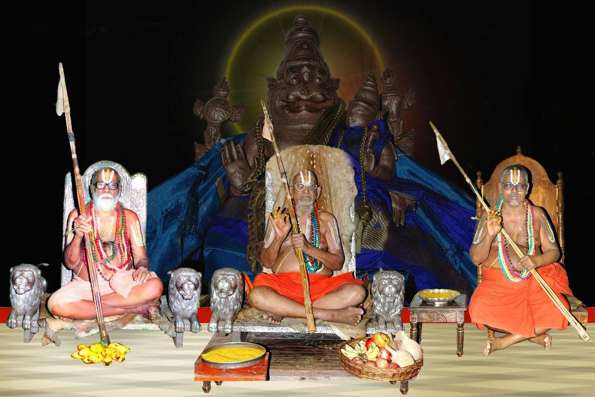Article by : Sadagopan Iyengar Swami, Coimbatore
“The Guruparampara Saram” is indeed a fitting prelude to Srimad Rahasyatraya Saram, for it lays down the essence of what one has to do to attain mokhshA-, which is to seek out and obtain refuge in an Acharya. In a sense, one might say that the rest of ” Srimad Rahasyatraya Saram” is but an elaboration of “Sri Guruparampara Saram”, for the presence or absence of Guru Bhakti determines whether a person attains liberation and becomes eligible for eternal service to the Lord, or remains interminably bound by mortal shackles (“Pirandum setthum nindru idarum pEdamai”, as Sri Nammazhwar calls it).
Having sought refuge in an Acharya and been shown the way to emancipation, what is the duty of the disciple? He should not only remember the Guru with undying gratitude, but also publicize the Acharyas greatness at every possible opportunity (“Potri ugappadum, pundiyil koLvadum,Pongu pugazh sAtri vaLarppadum”). This not only helps the disciple in keeping alive his grateful memories, but also encourages uninitiated others to approach the Acharya and benefit therefrom. A beautiful sloka from the Sesha SamhitA impresses Swami Desikan so much, that he not only quotes it in his magnum opus,but also provides considerable elaboration for the same.
“Gurum prakAsayEt dheemAn, Mantram yatnEna gOpayEt
aprakAsa prakAsAbhyAm ksheeyatE sampat AyushI”
Whether a person remembers and sings the praises of his Acharya depends upon the depth of his Guru bhakti. When our love or respect for someone is intense, we cannot refrain from speaking about that someone to anybody who might listen. We thus find parents speaking with pride of the exploits of their infants, lovers talking about each other to their respective friends, politicians paying constant tribute to their mentors, cinema buffs talking non-stop about their favourite matinee idol, and so on. Though not on the same plane, intense Acharya bhakti also prompts a person to constantly remember, venerate and adore his Guru. The first quarter of the aforesaid sloka lays down that the wise person publicises his Guru’s greatness. It follows, therefore, that those who do not do so are unwise. This is indeed true, for the Acharya’s assistance in the pilgrim’s progress is so immense that anyone who doesn’t remember or publicly acknowledge his Acharya’s greatness is definitely unworthy of his salt.
Are there precedents for such public acknowledgement and profuse praise of an Acharya by the beneficiary disciple? There are instances galore of this. All the Acharyas of our Guruparampara have had intense devotion and love for their preceptors, which have found expression in several slokas and whole stotras.
We thus find
– Sri Madurakavigal singing the praise of Sri Nammazhwar, to the specific exclusion of even the Lord (“ThEvu matru ariyEn”),
– Sri Alavandar acknowledging Sri Nathamuni.s greatness in the Stotra Ratna and other works, (
“namO achintya adbhuta aklishta gnAna vairAgya rAsayE
NathAya munayE agAdha bhagavat bhakti sindhavE”)
– Sri Ramanuja showering liberal praise on Sri Alavandar- (“YamunArya sudhAmbhOdhim avagAhya yatAmati AdhAya bhakti yOgAkhyam ratnam sandarsayAmi aham”) and other Acharyas too-
– Swami Desikan devoting an entire stotra of 70 slokas (“Sri Yatiraja Saptati”) to the praise of Sri Ramanuja, in which other Acharyas too come in for due adulation.
These are but a few instances of “Guru PrakAsanam” or public adoration of the Guru. Such intense devotion for the Acharya also enables better comprehension in the sishyA- the dedicated disciple is on a perfect wavelength with the Acharya, so as to be able to read his Acharya.s thoughts, without even a specific expression thereof.
We often find that some sishyAs are able to grasp the Acharya’s upadesa much better than others: Swami Desikan, quoting the Kata Shruti and the JAbAla shruti, attributes this uneven comprehension in peer disciples to the level of devotion each has towards the Acharya- the deeper the devotion, the better the comprehension, and vice versa.
– Sri Sanjaya, with his intense bhakti towards his Acharya Sri Vyasa, was able to watch and listen to the proceedings of the KurukshEtra war “live”, so to say- sitting in the comfort of DritharAshtrA’s palace
– UpakOsala, disciple of SatyakAma JabAla, was able to absorb the Brahma VidyA, even without his Acharya’s upadEsa. For those without such deep devotion to the Acharya, spiritual knowledge is difficult to attain and sustain. Thus, spiritual accomplishments are directly proportionate to the intensity of one’s Acharya bhakti.
to be continued…
Article by : Sadagopan Iyengar Swami, Coimbatore









